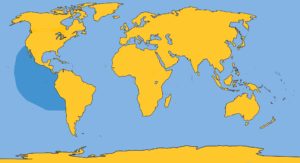Lesser Beaked Whale, Peruvian beaked whale
Family: Ziphiidae
Genus: Mesoplodon
Species: M. peruvianus Reyes, Mead, and Weerebeek, 1991
The pygmy beaked whale is the smallest of all beaked whales, and was discovered in 1991 from a specimen that drowned in a coastal fishing net. It is known from only 13 dead specimens and less than seventy confirmed sightings. Little is known of it because of its remote habitat, its elusive nature, and its almost identical size, shape, and coloration of Hector’s beaked whale, which is why we included that animal’s portrait above.
Physical Description: They have a spindle-shaped body, typical of all Mesoplodons. There is a slight indentation at the blowhole.
Color: Dark gray, dissolving to lighter color on the underside. Males have a pale chevron pattern on their back.
Fins and Flukes: A prominent falcate dorsal fin is located two-thirds of the way down the body. The flippers are tiny and the flukes are thick and slightly pointed with no median notch.
Length and Weight: Thought to be 11.5 to 12 ft (3.4 to 3.7 m). The males are thought to be slightly larger than females.
Teeth: There are two tiny teeth at the tip of the lower jaw.
Feeding: Presumably mid- to deep-sea fish and squid.
Breathing and Diving: They move quickly away from motor vessels, making any pattern difficult to determine. The blow is very inconspicuous.
Mating and Breeding: Little is known. Calves are born at about 5 ft (1.5 m).
Herding: Sightings of 2 to 3 animals have been reported.
Distribution: They are predominantly found in mid- to deep-sea waters off Peru, although strandings have occurred off Mexico, and one off Monterey Bay, California, and another off New Zealand.
Migration: No information available.
PYGMY BEAKED WHALE DISTRIBUTION







